DOCSIS
Interop Puts DOCSIS 4.0 Technology’s Speed and Stability Front and Center

Key Points
- The first DOCSIS® 4.0 Interop·Labs event of 2025 focused on speed and stability, providing another opportunity to test interoperability scenarios between products leveraging DOCSIS 4.0 technology.
- If you are attending CableLabs Winter Conference, join us for “The What, Why and How of Future HFC Solutions” to explore the potential of future generations of DOCSIS networks.
As the world of broadband connectivity evolves, so does the technology that powers it. The evolution of DOCSIS technology has been a cornerstone of high-speed internet delivery, enabling service providers to meet the growing demands for faster and more reliable internet access. DOCSIS 4.0 technology represents the latest milestone in this journey, offering impressive speeds and new capabilities.
The latest Interop·Labs event, which took place Feb. 10–13 at CableLabs in Louisville, Colorado, showcased these capabilities and more, focusing on speed and stability — crucial factors in determining the quality and reliability of an internet connection.
A Bright Future for DOCSIS 4.0 Technology
DOCSIS 4.0 technology is poised to revolutionize broadband connectivity, offering significantly faster speeds, better efficiency and enhanced security. Its backward compatibility with existing DOCSIS 3.0/3.1 infrastructure makes it a flexible solution for both service providers and consumers.
As with any major technological leap, ensuring smooth interoperability between old and new systems is key to a successful transition. By offering a scalable, future-proof solution that can be deployed gradually, DOCSIS 4.0 technology allows operators to gracefully migrate to these new products.
Why Speed and Stability Are Critical
Speed refers to how quickly data is downloaded or uploaded, often measured in megabits per second (Mbps), and plays a key role in activities such as streaming, gaming and video conferencing. Stability, on the other hand, is about the consistency of that connection.
A stable connection ensures that users experience minimal interruptions or slowdowns, even during peak usage times. Both high speed and stable performance are essential for seamless online experiences, especially in households or businesses that rely on multiple devices or heavy internet usage.
Key Contributors and Participants
The DOCSIS 4.0 specifications describe both frequency division duplex (FDD) and full duplex (FDX) modes of operation. For this interop, the first of 2025, new modems and RPDs that supported both modes (on the same device) were participants for the first time.
Attendance at the interop was high and included new suppliers and products, as well as two operators that joined to observe demonstrations, interact with the suppliers and discuss their own DOCSIS 4.0 network progress.
Suppliers included CommScope and Harmonic, who brought DOCSIS 4.0 CCAP cores to the event. For the first time, we saw new Remote PHY Device (RPD) platforms from three separate suppliers: Harmonic, Teleste and Vecima. Seven DOCSIS 4.0 modem suppliers — Arcadyan, Askey, Gemtek, Hitron, Sagemcom, Sercomm and Ubee — brought multiple cable modem models. Calian participated with its test solutions, and Microchip participated with its clock and timing system.
Broadcom has developed new chipsets that enable a device to operate in either FDD or FDX mode, under the control of the network. Another chipset supplier, MaxLinear, was also in attendance, exhibiting its latest DOCSIS 4.0 modem innovations.
Testing scenarios involved using a virtual core from one supplier, and RPDs and DOCSIS 4.0 cable modems from various other suppliers. The products were mixed and matched to verify interoperability scenarios and speeds through the system. As before, DOCSIS 3.1 and DOCSIS 4.0 devices were combined to demonstrate the cross-compatibility of existing and new technology. Suppliers providing test equipment used these setups to verify their solutions.
Broadband Service Enhancement
The February interop was another opportunity to drive interoperability between some of these new products/platforms and some existing ones, ensuring that the different systems and devices would seamlessly work together to exchange information. Interoperability is vital to enabling these devices to connect and interact. By fostering interoperability, the DOCSIS ecosystem continues to provide innovation and solutions to enhance broadband services, ultimately leading to better outcomes for consumers.
Remote PHY Interoperability
Although modems were the focus, the event also looked at the interoperability between DOCSIS 4.0 cores and RPDs. We branched into more and different configurations, moving beyond one-size-fits-all configurations. These products are going to be deployed in many scenarios, and going deeper into these various configurations will ensure flexibility as DOCSIS 4.0 technology moves into the field.
Join Us Soon
The next DOCSIS 4.0 interop is planned for the week of March 31 at CableLabs.
If you are a member or vendor attending CableLabs Winter Conference, join us for our two-part session “The What, Why and How of Future HFC Solutions.” We’ll explore the potential of future generations of DOCSIS networks, exploring how the evolution of the technology will support tomorrow’s hybrid fiber coax networks. This two-part session begins at 12:45 Tuesday, March 11.
With DOCSIS 4.0 technology, the future of broadband looks brighter, faster and more connected than ever before. The technology’s seamless integration into current systems ensures that consumers will continue to benefit from fast, reliable internet — no matter where they are on their broadband journey.
DOCSIS
DOCSIS 4.0 Interop Delivers on the 10G Playbook

Key Points
- The primary takeaways from the latest DOCSIS®️ 4.0 event involved performance, interoperability, energy efficiency and reliability.
- Detailed interoperability discussions focused on the virtualized CMTS core, remote PHY devices (RPDs) and modems in various real-world configurations, exploring how everything unambiguously works together.
- Energy-management features showed that it’s not just about speed but also about how the right technology can enhance customer experience.
At the latest DOCSIS 4.0 Interop·Labs event — which took place Nov. 4–7 at CableLabs’ headquarters in Louisville, Colorado — equipment suppliers showcased their efforts to deliver on the 10G platform through DOCSIS 4.0 technology. All four 10G pillars were on display: faster speeds, lower latency, enhanced security and increased reliability. These pillars were all designed into the DOCSIS 4.0 specifications, and we’ve reached the point at which the products simply work.
We want to thank the participants who helped make the event successful and once again helped us achieve a high level of productivity. To recap the major themes of the event:
- Speeds are rock solid. Demonstrations boasted downstream speeds faster than 9 Gbps that were limited only by the single 10 Gbps interface on the modems. Upstream speeds can exceed 2 Gbps on and go even higher.
- The new focus is interoperability. Products are maturing, and suppliers are differentiating their offerings. As operators continue to seriously develop deployment scenarios, we want to ensure that the specifications are clear enough to handle real-world deployment, including specific configurations, corner cases and race conditions. Four operators attended this interop to provide guidance on deployment scenarios. Much effort went into exercising interoperability and identifying areas for work.
- Energy efficiency is on the rise. A burgeoning trend at this interop was energy management. New features will benefit consumers by providing options to conserve energy in various scenarios.
- Reliability is a reliable theme. We continue to examine the copious data available from the modems — in particular, DOCSIS 4.0 cable modem Proactive Network Maintenance (PNM) functions that can be used to increase the reliability of service offerings.
Supplier Participation
Attendance at the interop was high, as it offered the last best opportunity to get this work in before the 2024 holiday season arrived. The aforementioned operators who joined us to observe demonstrations went out of their way to interact with suppliers and talk about their own DOCSIS 4.0 network progress.
Among the suppliers were CommScope and Harmonic, both of which brought DOCSIS 4.0 cores to the interop. There were also three 1.8 GHz remote PHY devices (RPDs) from CommScope, Harmonic and Vecima Networks. In addition, seven DOCSIS 4.0 modem suppliers — Arcadyan, Askey, Gemtek, Hitron, Sagemcom, Sercomm and Ubee Interactive — brought multiple cable modem models. Calian participated with its suite of DOCSIS technology analyzers and tools.
Remote-PHY Interoperability
The DOCSIS modem termination system (CMTS) has been virtualized, and the software portion is referred to as the core. The physical layer of the CMTS has moved to the RPD in the fiber node. In other words, the CMTS has been disaggregated, and the core and RPD can (and will) come from different suppliers. The modem can come from yet another supplier. These three pieces need to work together to provide service.
At our interop events, we like to delve into multiple real-world configurations. The core calls the shots and configures the RPD for the downstream and upstream signals, and then the core manages the DOCSIS cable modems. Flexibility is built into this scenario, however, and we’re constantly working to get everything right and interoperable. It’s for this reason that operators attend the interop events — to clarify how DOCSIS 4.0 technology can be introduced to the networks, including backward compatibility with existing services.
Energy Management
Energy management is an important function for cable modems. DOCSIS cable modems and cores support a low-power energy mode called the Energy Management (EM) mode. During idle times, when a single upstream and downstream channel can meet a user’s data-rate demand, the cable modem switches to EM mode. When the modem requires a higher data rate than the reduced set of channels can provide, the core instructs the modem to return to the larger transmit-and-receive channel set.
EM mode can also be used during a power outage — for example, when a modem goes into battery back-up but continues to provide digital phone service. In this scenario, EM mode can conserve battery power when the traffic is low, exhibiting minimum impact on normal service, to prolong access to digital voice service, especially the 911 emergency call service.
The EM feature shows how people rely on their broadband connection for all services, not just web and email. The feature also reveals how DOCSIS technology has evolved to address these needs as a broadband service of choice.
Proactive Network Maintenance
PNM is an important function that increases network reliability. We always look at the PNM data available from DOCSIS device, because it’s a sign of product maturity. This PNM data enables the most efficient operation of the coaxial cable network, keeping the data levels at their peak by using the more efficient orthogonal frequency-division multiplexing (OFDM) and OFDM access (OFDMA) signals, and allowing the diagnosis and maintenance of the network before consumers ever notice an issue.
Join Us Next Time!
We’ve gone beyond the basics of the four pillars. The focus of our DOCSIS 4.0 interops is now interoperability, interoperability and more interoperability! These products are soon headed to the field, in various configurations with multiple suppliers’ products having to work together. And this work will continue into 2025 as DOCSIS 4.0 technology comes into use.
The next DOCSIS 4.0 interop event is planned for the week of Feb. 10, 2025, at CableLabs’ headquarters in Louisville, Colorado. The event will provide an opportunity for new suppliers and new products as we kick off the new calendar year.
And don’t forget: Right around the corner in March 2025 are CableLabs Winter Conference and Smaller Market Conference.
DOCSIS
DOCSIS 4.0 Interop Dives Deeper Into Upstream Speed and SCTE TechExpo24 Prep
Key Points
- The latest DOCSIS® 4.0 Interop·Labs event took a deeper look at upstream speeds.
- The event provided suppliers an opportunity to sharpen their products — and pitches — for the upcoming SCTE®️ TechExpo conference in Atlanta.
At the latest DOCSIS 4.0 Interop·Labs event, a record number of modem suppliers were on hand to delve deep into upstream speed and other aspects of the DOCSIS 4.0 specifications. We want to thank the participants who helped make the event successful and once again helped us achieve a high level of productivity.
We cannot highlight enough how CableLabs provides a neutral testing ground for suppliers and operators to come together and showcase compatibility across interfaces defined in our DOCSIS 4.0 specifications. The gathering of suppliers and products in one location is extremely valuable to the participants to see how the technology is being implemented across multiple platforms. The DOCSIS 4.0 specifications are proscriptive, yet there’s plenty of room for innovation to differentiate products and offerings.
Combining interoperability events for these technologies drives home the fact that compatibility across all system components is a high priority for the industry.
To recap:
- Everything is coming up gigabits!
- Downstream speeds faster than 9 Gbps through a DOCSIS 4.0 modem are the new normal, limited only by the availability of a single 10 Gbps interface on the modems.
- Upstream speeds now exceed 2 Gbps on DOCSIS 4.0 modems and can go higher.
- We continue to examine the copious data available from the modems — in particular, DOCSIS 4.0 cable modem Proactive Network Maintenance (PNM) functions.
- DOCSIS 4.0 security technologies are coming along nicely, and their recent availability showcases the advancing maturity of the products.
DOCSIS 4.0 technology is putting down a marker. These products are delivering on the promise of multi-gigabit speeds that will benefit consumers around the world. Among suppliers and operators in our labs, we’re seeing unprecedented passion for interoperability, for unrivaled speeds and for getting these products to market.
Record Supplier Participation
Attendance at the interop was high, including new suppliers and products. Three operators joined us to observe demonstrations, interact with the suppliers and talk about their own DOCSIS 4.0 network progress.
Among the suppliers were CommScope and Harmonic, which brought DOCSIS 4.0 cores to the interop. For the first time, we saw three 1.8 GHz Remote PHY Devices (RPDs) from separate suppliers including CommScope, Harmonic and Vecima Networks. Also, for the first time, eight DOCSIS 4.0 modem suppliers — Arcadyan, Askey, Gemtek, Hitron Technologies, Sagemcom, Sercomm, Ubee Interactive and Vantiva — brought multiple cable modem models. Microchip Technology participated with its clock and timing system. The availability of record numbers of both DOCSIS 4.0 RPDs and DOCSIS 4.0 cable modems shows that products continue to proliferate as these suppliers prepare for SCTE TechExpo 2024 later this month.
Testing scenarios involved using a virtual core from one supplier, and RPDs and DOCSIS 4.0 cable modems from various other suppliers. The products were mixed and matched to verify interoperability scenarios and speeds through the system. As before, DOCSIS 3.1 and DOCSIS 4.0 devices were combined to demonstrate the cross-compatibility of existing and new technology. Suppliers providing test equipment used these setups to verify their solutions.
Sustained Speed
Achieving a rate of 9 Gbps (or faster) downstream through a DOCSIS 4.0 cable modem is now the new normal. Multigigabit speed is a core pillar of the 10G platform. At this interop, all modems achieved that downstream rate of speed — testament to the work achieved at previous interops.
At the August interop, we looked at upstream speed — that is, the stability of very high-speed traffic on upstream channels. Using a DOCSIS 4.0 ultra-high split, the modems in attendance consistently achieved more than 2 Gbps upstream. Upstream is trickier than the downstream: Whereas downstream is a continuous broadcast from one transmitter (the RPD), upstream is bursty, consisting of multiple modems contributing to the orthogonal frequency-division multiple access (OFDMA) signals that the RPD has to “catch” and accurately demodulate. That upstream burst receiver in the RPD is arguably the most complicated component of the system, especially considering the data rates in play.
So, we’ve arrived at a point where a DOCSIS 4.0 modem is pairing download speeds faster than 9 Gbps with upload speeds faster than 2 Gbps (and with the capability to go even faster). And we’re talking about a single modem. The service group can achieve even more capacity and speed, which means individual modems can also go higher.
Additional DOCSIS 4.0 Cable Modem Operations
Beyond speed, three other aspects of DOCSIS 4.0 technology stood out, offering a look at the maturity of the products at the interop.
PNM
PNM is an important function for cable modems. It’s a proven tool that engineers and technicians use for maintenance, troubleshooting and improvement of the cable plant. More and more, the signals on the plant are OFDM and OFDMA, which provide higher speeds and capacities than traditional quadrature amplitude modulation (QAM) signals.
At this event, we looked at five PNM tests that were run on all the modems. And because DOCSIS 4.0 modems generate more OFDM and OFDMA signals, more data is available. This is a sign of product maturity, responding to these data requests. And the modems have this down. This PNM data will enable the most efficient operation of the coaxial cable network, keeping the data levels at their peak by using the more efficient OFDM and OFDMA signals.
Security
Cable broadband is widely deployed. Hundreds of millions of consumers use DOCSIS technology every day as they live, work, learn and play. DOCSIS 4.0 technology includes strengthened measures to meet the threats that come with online activity. Suffice it to say, new security features are now appearing in products in the labs, and they’re being tested for both functionality and interoperability.
Remote PHY Interoperability
Although modems were the focus, the event also looked at the interoperability between DOCSIS 4.0 cores and RPDs. We branched into more and different configurations, moving beyond “one size fits all” configurations. These products are going to be deployed in many scenarios, and going deeper into these various configurations will ensure flexibility as DOCSIS 4.0 technology moves into the field.
Join Us Next Time
The next DOCSIS 4.0 interop is planned for the week of Nov. 4 at CableLabs’ headquarters in Louisville, Colorado. The event will provide an opportunity for both new suppliers and new products as we all prepare for the new calendar year.
Right around the corner in March 2025 are CableLabs Winter Conference and Smaller Market Conference.
DOCSIS
DOCSIS 4.0 Interop·Labs: A Year of Progress and Collaboration
Key Points
- The latest DOCSIS® 4.0 Interop·Labs event involved a deeper look at products to showcase the continuing maturity of the DOCSIS 4.0 ecosystem.
- The event examined speed in a new way, verifying long-term high speed through the system — capabilities that can lead to new products and services for consumers.
- Interop events began in July 2023 after the launch of the CableLabs DOCSIS 4.0 Cable Modem Certification program.
Achieving interoperability in the broadband industry is no small feat. It takes time, patience and attention to detail. Collaboration, problem-solving and flexibility. But, once achieved, interoperability powers innovation and competition within the ecosystem. It enables expanded market opportunities for equipment suppliers and offers operators more options for their subscriber services.
CableLabs provides a neutral testing ground for those suppliers and operators to come together and showcase compatibility across interfaces defined in our DOCSIS 4.0 specifications. Since the launch of the CableLabs DOCSIS 4.0 Cable Modem Certification program in June 2023, we’ve spent many action-packed weeks hosting DOCSIS 4.0 Interop·Labs events. And how far we’ve come in just a year! To recap briefly:
- We’ve achieved a downstream speed of over 9 Gbps through a DOCSIS 4.0 modem — a speed record.
- Testing scenarios have focused on combining DOCSIS 4.0 modems and Remote PHY equipment, as well as DOCSIS 3.1 and DOCSIS 4.0 equipment together, to demonstrate flexibility and backward compatibility.
- We’ve explored network reliability — in particular, DOCSIS 4.0 cable modem proactive network maintenance (PNM) functions in DOCSIS 4.0 cable modem termination systems — and DOCSIS 4.0 security technologies.
DOCSIS 4.0 and DAA Technologies
That momentum is continuing with the success of CableLabs and Kyrio’s most recent event, which combined DOCSIS 4.0 technology and Distributed Access Architecture (DAA). Combining interoperability events for these technologies drives home the importance of compatibility across all system components.
During the June 24–27 event, attendees pushed even deeper into testing the products to examine the intricacies of interoperability in a more nuanced way. Thank you to the participants who helped make the event successful — and once again — helped us unlock a new level of productivity.
The featured exercises involved DOCSIS 4.0 cable modems and DAA equipment. The DAA products included Remote MACPHY devices and Remote PHY equipment such as virtualized cores and Remote PHY Devices (RPDs) that support DOCSIS 4.0 technology. All of these systems came together during the week of exercises to demonstrate multi-supplier interoperability across the DOCSIS ecosystem.
Continued High Level of Participation
Attendance remained high with new suppliers and new products. Operators joined us to observe, interact with the suppliers and talk about their own DOCSIS 4.0 network progress.
Among the suppliers were Casa Systems, CommScope and Harmonic, which brought DOCSIS 4.0 cores to the interop. Remote PHY Devices (RPDs) from Casa Systems, CommScope, DCT-DELTA, Harmonic and Vecima Networks offered a mix of DOCSIS 3.1 and DOCSIS 4.0 technologies. DOCSIS 4.0 cable modems were provided by Arcadyan, Askey, Hitron Technologies, MaxLinear, Sagemcom, Sercomm and Ubee Interactive. Calian attended with its Remote PHY test system, which can be used to verify interoperability between DOCSIS 4.0 cable modems and a DOCSIS 4.0 core. Microchip Technology participated with its clock and timing system. Rohde & Schwarz brought its DOCSIS Signal Analyzer for continued development on DOCSIS 4.0 systems.
Testing scenarios involved using a virtual core from one supplier, and multiple RPDs and DOCSIS 4.0 cable modems from various suppliers. The products were mixed and matched to verify interoperability scenarios and speeds through the system. As before, DOCSIS 3.1 and DOCSIS 4.0 equipment were combined to demonstrate the cross-compatibility of existing and new technology. The test equipment suppliers used these setups to verify their solutions.
This interop had a different vibe than past events but proved that DOCSIS 4.0 modems continue to mature, which is enabling new investigations into the technology.
Sustained Speed
Achieving a rate of 9 Gbps (or more) downstream through a DOCSIS 4.0 cable modem is now the new normal. We’ve now achieved it on multiple modems and multiple cores. (And stay tuned. We’re now expecting DOCSIS 4.0 modems that can exceed speeds of 10 Gbps!)
In the July interop, we began looking at sustained speed — that is, the stability of very high-speed traffic over several hours. One test used two modems on a virtual core and RPD and ran 4 Gbps through each modem (8 Gbps through the core) for three hours, with no loss of data. That was over 5 terabytes (TB) of download per modem in 3 hours!
We also tried to find out how fast a system could download 1 TB. By putting 9.2 Gbps through a modem, we reached the 1 TB download in 18 minutes. That’s up to 50 hours of 4K movie content. More importantly, imagine what these speeds could mean for future services like home health care. This rate of high-speed data transfer will no doubt lead to transformative new products and services for the connected home.
Cable Modem PNM Operations
PNM is an important function for cable modems. These proven tools are used by engineers and technicians for maintenance, troubleshooting and improvement of the cable plant. More and more, the signals on the plant are orthogonal frequency division multiplexing (OFDM) and orthogonal frequency division multiple access (OFDMA), which provide higher speeds and capacities than traditional quadrature amplitude modulation (QAM) signals.
At this interop, we looked at five different PNM tests, specifically getting data from DOCSIS 4.0 cable modems and verifying interoperability with the application programming interfaces (APIs) and with the data generated by the modems. This PNM data will enable the most efficient operation of the coaxial cable network, keeping the data levels at their peak by using the more efficient OFDM and OFDMA signals.
Remote PHY Interoperability
While the modems were the focus, this event also included a deeper look at the interoperability between DOCSIS 4.0 cores and RPDs. These will be new infrastructure for operators and another interface around which interoperability must be proven. To facilitate best-in-class infrastructure for new DOCSIS 4.0 products and services, this interface has to demonstrate flexibility to allow configurations and channel plans that work best for an operator.
At the interop, we spent time purposely trying these new configurations. We sought to ensure the components asking for resources and assigning those resources can communicate and allow for flexibility in configuration that can be used in the new future as DOCSIS 4.0 technology moves into the field.
Join Us at SCTE TechExpo
The next DOCSIS 4.0 interop is planned for the week of Aug. 12 at CableLabs’ headquarters in Louisville, Colorado. The event will provide suppliers an opportunity to sharpen their products — and pitches — for the upcoming SCTE®️ TechExpo conference in Atlanta.
At TechExpo, the must-attend event for the broadband industry, CableLabs will highlight the products and efforts that occur at our Interop·Labs events. Full-access passes are free for CableLabs members. Register now to join us!
DOCSIS
A Busy DOCSIS 4.0 Interop Event Sets a New Downstream Speed Record
Key Points
- The latest DOCSIS® 4.0 Interop•Labs event involved new suppliers bringing new products, showcasing the depth and breadth of the DOCSIS ecosystem.
- Multi-vendor interoperability testing at the event allowed us to achieve a downstream speed of over 9 Gbps through a DOCSIS 4.0 modem — a new speed record.
- Interops keep getting busier, highlighting the continued importance of interoperability across the industry.
CableLabs and Kyrio hosted a combined DOCSIS 4.0 technology and Distributed Access Architecture (DAA) Interop•Labs event April 15–18 at our headquarters in Louisville, Colorado. Combining the interops for these technologies drives home the fact that interoperability across all the system components is a high priority for the industry.
And once again, the operators and suppliers in attendance made this event the most successful interop to date — and the busiest. We even achieved a downstream speed of over 9 Gbps through a DOCSIS 4.0 cable modem!
At this Interop•Labs event, the focus again was on interoperability. The featured exercises involved DOCSIS 4.0 cable modems and Remote PHY equipment, including virtualized cores and Remote PHY Devices (RPDs) that support DOCSIS 4.0 technology. During the week, the mixing and matching of systems and components demonstrated multi-supplier interoperability across the DOCSIS 4.0 ecosystem.
Record-Setting Number of Devices
The event included new suppliers who brought new products, showcasing the depth and breadth of the DOCSIS ecosystem. We set a record for the highest number of DOCSIS 4.0 cable modems and the most RPDs involved in a single interop! Operators also attended to observe demonstrations, interact with suppliers and talk about their own DOCSIS 4.0 technology plans.
As you can probably guess, it was the busiest interop yet. With all the equipment, suppliers and operators on site, it was standing room only in the interop lab — not a bad problem to have. The sheer number of attendees meant we had to move quickly through test scenarios.
Casa Systems, CommScope and Harmonic brought DOCSIS 4.0 cores to the interop, and Calian, Casa Systems, CommScope, DCT-DELTA, Harmonic and Vecima Networks brought RPDs that offered a mix of DOCSIS 3.1 and DOCSIS 4.0 technologies. Arcadyan, Askey, Hitron Technologies, MaxLinear, Sagemcom, Ubee Interactive and Vantiva showcased DOCSIS 4.0 cable modems. Rohde & Schwarz brought its DOCSIS 4.0 test and measurement system, and Microchip Technology participated with its clock and timing system.
Testing scenarios involved using a virtual core from one supplier, an RPD from another supplier and multiple DOCSIS 4.0 modems from various suppliers. The products were mixed and matched to verify interoperability scenarios and speeds through the system. As before, DOCSIS 3.1 and DOCSIS 4.0 equipment were mixed to demonstrate cross-compatibility of existing and new technology. The test equipment suppliers used these setups to verify their solutions.
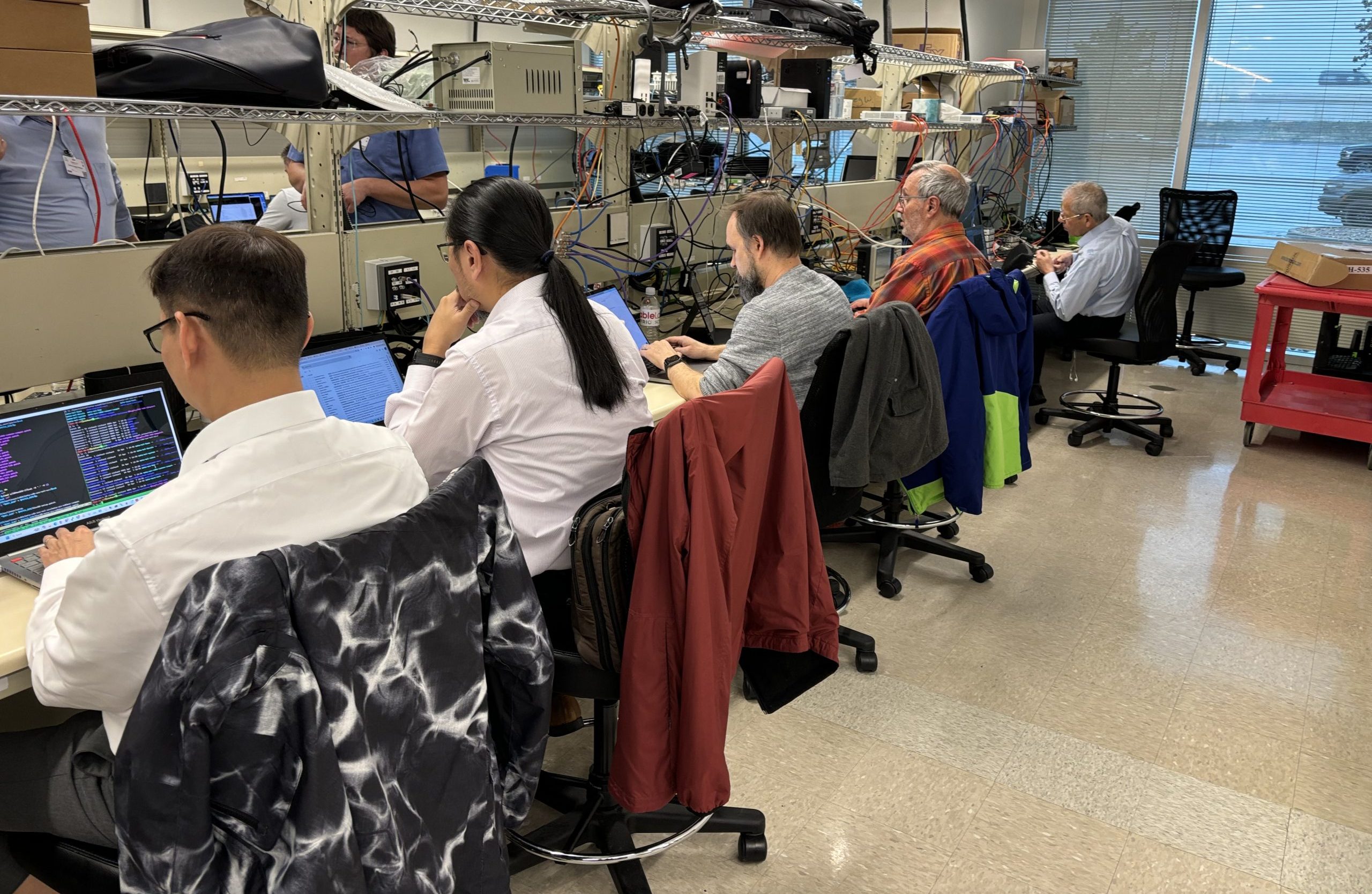
An Interop•Labs event combined both DOCSIS 4.0 and Distributed Access Architecture technologies in interoperability testing scenarios.
9 Gbps Downstream Speed Unlocked
Multi-vendor interoperability testing is how we achieved a downstream speed of over 9 Gbps. This speed record shows several things: First, the products are nearing feature-complete status and are now being optimized for the speeds that DOCSIS 4.0 technology will bring to market.
Second, DOCSIS 4.0 technology will compete effectively with 10 gigabit passive optical network (PON) solutions that max out at about 8.5 Gbps downstream. DOCSIS 4.0 technology won’t only surpass that speed but will also provide more throughput to the neighborhood than what is possible with 10 gigabit PON. And lastly, these speeds are available over existing coaxial cable already serving tens of millions of customers around the globe.
It's About Network Cohesion
The number of suppliers and products in the industry continues to rise, and CableLabs’ Interop•Labs events bring all of the components of a DOCSIS 4.0 network solution together. With each interop, we’re successfully mixing and matching products from various suppliers and demonstrating interoperability across the interfaces defined in CableLabs’ specification.
In addition, together we’re achieving the multi-gigabit speeds and other advanced capabilities of DOCSIS 4.0 technology such as security, low latency and proactive network maintenance. Other parts of the DOCSIS 4.0 ecosystem are also becoming available, including hybrid fiber coax (HFC) network equipment such as amplifiers, taps and passives.
It’s exciting work, and we’re always looking forward to the new developments and takeaways that come out of events like these. Catch up on past interops and click the button below to stay up to date on future DOCSIS technology interop events.

DOCSIS
Combined DOCSIS 4.0 Interop Event Stresses Network Interoperability and Virtualization
Key Points
- The recent Interop•Labs event combined systems and components to demonstrate multi-supplier interoperability across the DOCSIS 4.0 ecosystem.
- Test scenarios included combining DOCSIS 3.1 and DOCSIS 4.0 equipment to demonstrate additional flexibility for operators.
- Interoperability is key to creating a healthier ecosystem because it enables more competition and operator scalability.
CableLabs and Kyrio hosted a combined DOCSIS® 4.0 technology and Distributed Access Architecture (DAA) Interop•Labs event February 12–15 at our headquarters in Louisville, Colorado. This was the first combined interop between CableLabs and its subsidiary, and the involved suppliers and operators made it a success.
At this Interop•Labs event, the exercises included both DOCSIS 4.0 cable modems and Remote PHY equipment, including virtualized cores and Remote PHY Devices (RPDs) that support DOCSIS 4.0 technology. During the week, mixing and matching of systems and components demonstrated multi-supplier interoperability across the DOCSIS 4.0 ecosystem.
Interop Takeaways
Casa Systems, CommScope and Harmonic brought DOCSIS 4.0 cores to the interop, and Casa Systems, Cisco, CommScope, DCT-DELTA, Harmonic, Teleste and Vecima brought RPDs that offered a mix of DOCSIS 3.1 and DOCSIS 4.0 technologies. Arcadyan, MaxLinear and Ubee Interactive showcased DOCSIS 4.0 modems. Rohde & Schwarz also participated with its DOCSIS 4.0 test and measurement system. Operators attended to observe the interop, interact with the suppliers and talk about their DOCSIS 4.0 technology plans.
The focus of the interop was interoperability across the ecosystem. A common test scenario at the event involved a virtual core from supplier A, an RPD from supplier B and a DOCSIS 4.0 modem from supplier C, all connected and operating according to specifications. The products were mixed and matched to investigate interoperability scenarios, with suppliers pitching in to analyze the results. To demonstrate extra flexibility for cable operators, suppliers mixed DOCSIS 3.1 and DOCSIS 4.0 equipment because the specifications are written for cross-compatibility.
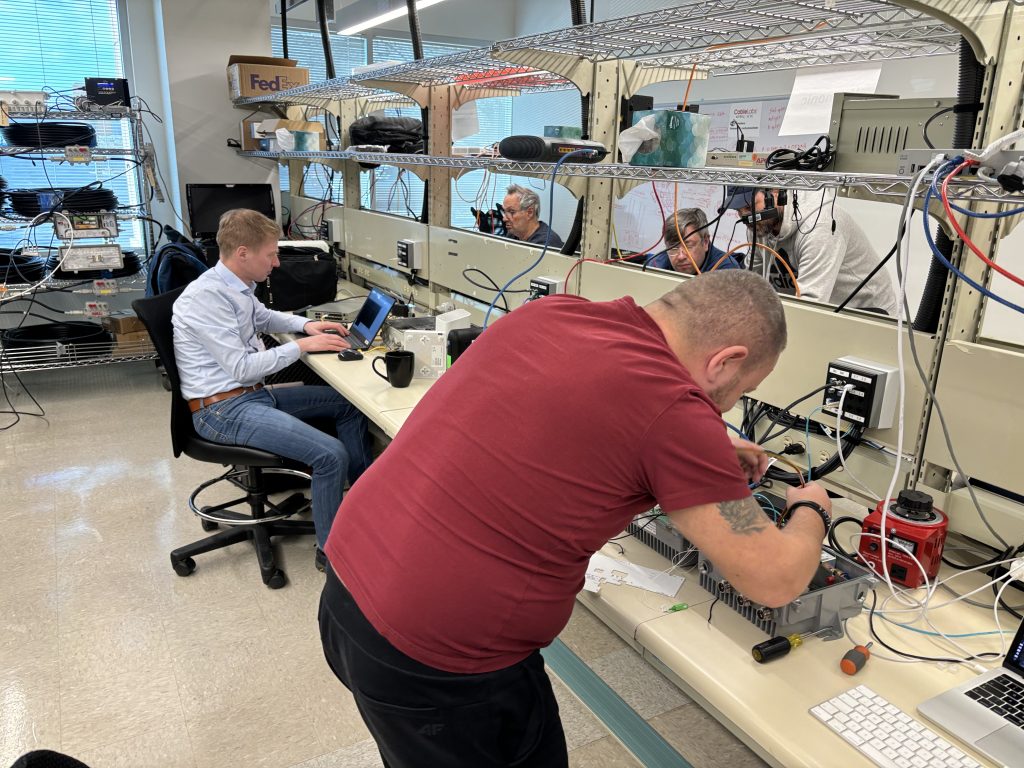
Above, engineers collaborate during the first combined DOCSIS 4.0 Interop•Labs event hosted by CableLabs and its subsidiary, Kyrio.
Interestingly, the interop illustrated how the traditional cable modem termination system (CMTS) has been disrupted by virtualization. Provided by one supplier, the CMTS used to be one box that did it all. Now, the software components have been abstracted into a virtual core that runs on servers in our data center, while the physical-layer components have migrated to the fiber node. This virtual architecture provides both better scalability and improved flexibility for the software, as well as better physical-layer performance on the coaxial cable. And in between, the fiber-optic cable uses much more scalable digital Ethernet connections.
The interop also demonstrated that the core and fiber node components can come from different suppliers because that interface is described in the CableLabs Remote PHY specifications. Looking at interoperability from all angles benefits all stakeholders. Interoperability enables a larger market in which suppliers can compete, which leads to varying competitive strategies and healthier ecosystems. Interoperability gives operators the confidence to plan large installations and the certainty that the equipment they put in the field this year will work for years to come.
Remote PHY interoperability events began in 2017 with DOCSIS 3.1 technology, so these solutions have been in the field for years and have matured. This interop shows that the migration to DOCSIS 4.0 technology is both very far along and proceeding smoothly — and that the supplier community has embraced interoperability among system components.
It's About Network Cohesion
The integration and optimization of the DOCSIS 4.0 ecosystem is underway. The goal has moved beyond simply booting DOCSIS 4.0 modems. Rather, we’re putting together all the parts, mixing and matching from different suppliers, demonstrating interoperability across the interfaces defined in CableLabs specification and achieving the multi-gigabit speeds and other advanced capabilities of DOCSIS 4.0 technology such as security, low latency and proactive network maintenance.
Other parts of the DOCSIS 4.0 ecosystem are also becoming available, including hybrid fiber coax (HFC) network equipment such as amplifiers, taps and passives.
To learn more about this exciting evolution, join us next month at CableLabs Winter Conference. This exclusive event for CableLabs members and the NDA vendor community will explore DOCSIS technology in two powerful sessions: “Unleashing the Full Potential of the DOCSIS 4.0 Network” and “A Vendor Perspective on DOCSIS 4.0 Technology Implementation.” You’ll hear from industry leaders about effective strategies, opportunities and benefits of the DOCSIS 4.0 network. Join us!

DOCSIS
Focus Shifts to Network Reliability in DOCSIS 4.0 Interop·Labs Event
CableLabs and Kyrio hosted a DOCSIS® 4.0 Interop·Labs event November 6–9 at our headquarters in Louisville, Colorado. It was a busy, week-long experience that highlighted multiple facets of DOCSIS 4.0 technology, and the many suppliers involved worked together to make it a success.
The primary focus of the event was network reliability — in particular, DOCSIS 4.0 cable modem (CM) proactive network maintenance (PNM) functions in DOCSIS 4.0 cable modem termination systems (CMTSs). There also were Remote PHY Device (RPD) interoperability exercises.
At this interop, four DOCSIS 4.0 CMs from four suppliers were interconnected to both DOCSIS 4.0 and DOCSIS 3.1 CMTSs from three companies. Participating suppliers were Arcadyan, Casa Systems, DCT-DELTA, Harmonic, Sagemcom, Ubee Interactive, and Vecima Networks. Rohde & Schwarz also participated with its DOCSIS 4.0 test system. Operators attended to observe the interop and talk about their DOCSIS 4.0 technology plans.
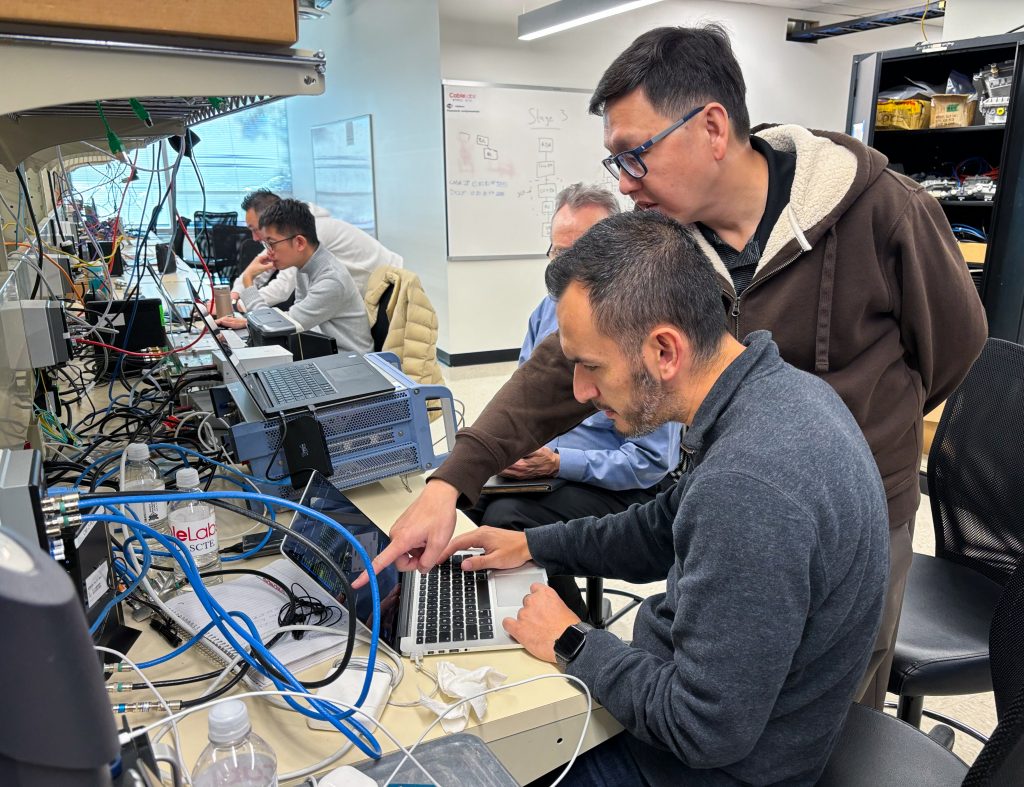
Engineers collaborate in a DOCSIS 4.0 Interop·Labs event at CableLabs' headquarters in November.
Network Reliability at the Forefront
Every day, hundreds of millions of broadband consumers use DOCSIS technology, and they depend on a reliable connection. DOCSIS PNM, which uses data provided by DOCSIS equipment, is foundational to the reliability of that connection.
For operators to keep tabs on the network and their offered services, data elements need to be both available and accurate. The goal of PNM is to fix issues before customers even realize there is a problem — before any service impacts occur.
PNM technology can be summarized into three areas: data collection, algorithms that use the data to analyze the network, and network operations to ensure continuous service.
Data collection. DOCSIS equipment generates vast amounts of network performance data to detect and measure issues within the cable plant. What kind of data? Data about both downstream and upstream RF performance, data on the spectrum in use, data on the signals on the coaxial cable, data on how the transmitters and receivers are operating, and more. At the interop event, we verified that the data reporting is both there and correctly formatted. For operator systems to use that data effectively, it has to be standardized in order for every modem from every manufacturer to report apples-to-apples information so that operator systems can use that data effectively.
Analysis algorithms. Once data is collected from the CMs, it’s run through algorithms to examine the health of the network. Systems sift through this data constantly, looking for anomalies. At the interop, the algorithms were discussed and compared, with operators describing how the data is used and what is being looked for.
Network operations. The DOCSIS PNM team maintains a reference document that describes how the data must be formatted, how it can be collected and which algorithms can be run on the data. Numerous SCTE Cable-Tec Expo papers discuss how to interpret the data and use it to maintain the network at the highest levels of service. The interop event featured eight high-runner PNM tests, collecting data from the DOCSIS equipment and putting it through algorithms. In the lab, it’s possible to simulate errored network conditions and use the data and algorithms to verify the condition of the network. SCTE is also involved with preparations for DOCSIS 4.0 tools and deployments, as Jason Rupe describes in the blog post “Ready, Set, 4.0: Tooling Up for DOCSIS Technology’s Rollout.”
A Comprehensive DOCSIS 4.0 Interop Event
Attending the event was one participant’s DOCSIS 4.0 virtual core platform and fiber node, which included a DOCSIS 4.0 extended spectrum DOCSIS (ESD) remote PHY device (RPD). This solution was a DOCSIS 4.0 ESD CMTS, and the DOCSIS 4.0 CM suppliers were excited to work with it. The DOCSIS 4.0 ESD CMTS operated both on a DOCSIS 4.0 ultra-high-split as well as up to 1.8 GHz on the coaxial cable. Both speed testing and security testing were examined against the DOCSIS 4.0 CMTS, continuing the work from previous interop events.
Remote-PHY Interop Exercises
DOCSIS 4.0 technology requires a distributed access architecture (DAA). At this interop, suppliers exhibited an array of DOCSIS 4.0 virtual cores. One supplier, which manufactures fiber nodes and RPDs, brought its DOCSIS 3.1 RPD with enhanced DOCSIS 3.1 capabilities. CableLabs and Kyrio were ready to support this kind of interop too. In essence, then, this wasn’t merely a DOCSIS 4.0 interop, but also a Remote PHY interop!
Collaborative DOCSIS Technology Evolution
At the DOCSIS 4.0 Interop·Labs event, CMTS and CM suppliers continued their efforts to verify that their equipment works together, further peeling the onion and diving into the nitty-gritty details of the specifications. This is where interoperability really happens.
All of the participants, along with us at CableLabs, left with a stronger understanding of product functionality and multi-vendor interoperability — and new work to do. Moving forward, the suppliers will continue to collaborate to refine their products and add further functionality.
Interop events are a major step toward large-scale deployment of DOCSIS 4.0 technology. Another step is certification. To find out more about Cable Modem Certification, click the button below.

DOCSIS
Security Gets the Spotlight at DOCSIS 4.0 Interop·Labs Event

CableLabs and Kyrio hosted a second DOCSIS® 4.0 Interop·Labs Event August 14–17 at our headquarters in Louisville, Colorado. This event built on our successes in July, focusing on interoperability between DOCSIS 4.0 cable modems (CMs) and DOCSIS 3.1 cable modem termination systems (CMTSs).
Attendance was up from the July interop, along with the addition of more CMs, CMTSs and test equipment. For this interop, seven DOCSIS 4.0 CMs from four suppliers were interconnected to seven DOCSIS 3.1 CMTSs from five companies. Participating suppliers were Arcadyan, Casa Systems, Cisco, CommScope, Harmonic, Sagemcom, Ubee Interactive, Vantiva and Vecima. EPIDoX.solutions and Rohde & Schwarz also attended with DOCSIS 4.0 test systems. Operators attended to observe the interop and talk about their DOCSIS 4.0 technology plans.
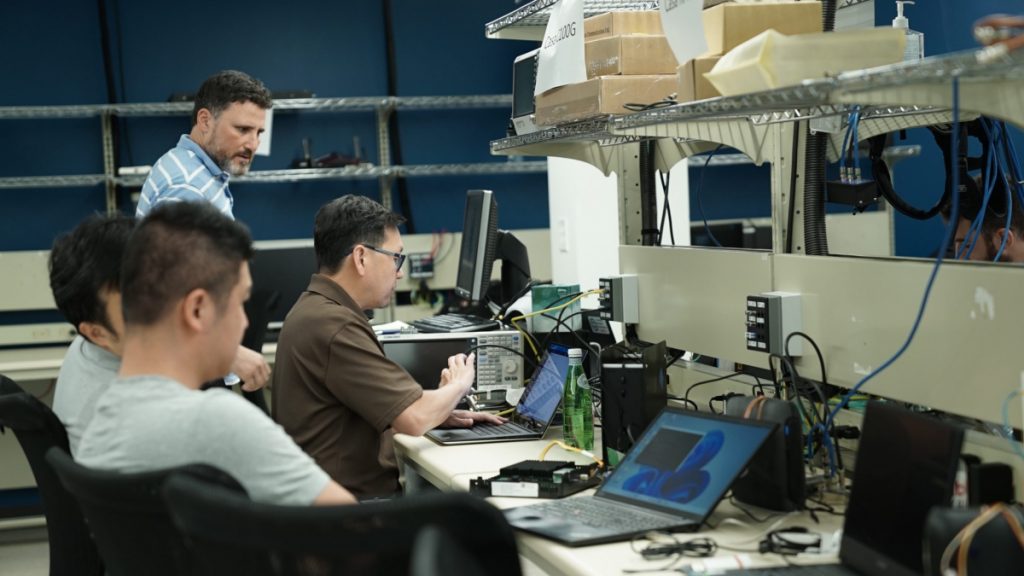
Engineers collaborate August 15 at the CableLabs DOCSIS 4.0 Interop·Labs Event.
Securing Customer Data Is Essential
The focus of this interop was security. Every day, tens of millions of broadband users connect with DOCSIS technology, using it for everything from ordering a pizza to sharing a video, from remote learning and remote medical appointments to purchasing household items and booking family vacations. Security in these activities is paramount to ensuring the best broadband experience possible.
Here’s an interesting tidbit about DOCSIS security: The methods we use at CableLabs are all published and available to the public — and always have been. DOCSIS security doesn’t depend on the secrecy of the implementation or its components. Rather, DOCSIS security is based on the strength of the algorithms and protocols in use, and these tools are updated from time to time to keep the security level high.
The security technologies are somewhat complex but can be summarized in two areas: authentication and encryption.
Authentication is as simple as the CM trusting the CMTS and the CMTS trusting the CM. It’s accomplished using digital certificates. DOCSIS technology has pioneered the use of public key cryptography on a mass scale. The DOCSIS public key infrastructure (PKI) is among the largest PKIs in the world, with half a billion active certificates issued and actively used every day.
Once authentication is complete and trust is established, the CM and CMTS exchange materials to encrypt the user traffic. Encryption makes the user traffic look like gibberish; without the means to decrypt the traffic, anyone snooping in on it would find it’s unintelligible. This methodology keeps users’ information secret.
As this Interop·Labs event examined interoperability with DOCSIS 3.1 CMTSs, it also looked at authentication and encryption, which are enabled by the Baseline Privacy Interface Plus (BPI+). A deeper dive on DOCSIS security capabilities can be found here, and further details about the cable security experience here.
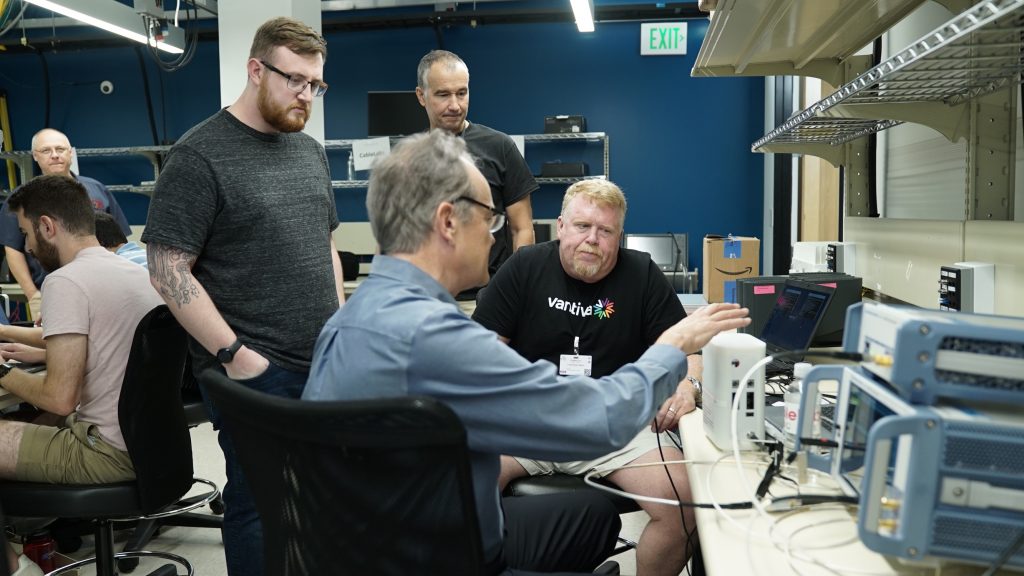
Engineers work together during the four-day event.
The Importance of Getting the Community Together
A big takeaway from the July interop was the importance of suppliers getting to know each other, creating relationships and collaborating ahead of this August interop. There’s been a lot of activity over this past month, at both CableLabs and supplier locations. The CableLabs security team was also busy ahead of time, working with suppliers to distribute materials and answer questions about DOCSIS security.
Because of this up-front work, we were able to get right to work on the August interop. With the latest products and software on hand, we stepped through all of the possible equipment combinations to explore how each worked to get CMs online with security.
Then, with security enabled, we again achieved the high speeds expected with DOCSIS 4.0 broadband — this time with line-rate encryption of the traffic. The highest downstream speeds were achieved with five 192 MHz OFDM channels (total of 960 MHz), which provided around 8.5 Gbps. On the upstream, a high-split channel lineup of QAMs and 2 OFDMA channels provided around 1.5 Gbps.
Everyone, including CableLabs, left the interop with new tasks to tackle, which is typically the case with maturing products and expected with events like these.
Overall, all of the participants left this interop in a good place, in terms of functionality and multi-vendor interoperability. From here, the suppliers can layer on additional functionality and add maturity to their products, working together in their own labs and at CableLabs.
Demonstrations at SCTE Cable-Tec Expo
The focus is now on successful technology demonstrations at the SCTE® Cable-Tec Expo® in October, in Denver, Colorado. Our experts will be on hand at booth 2201, so make plans to stop by if you’re attending.
We’re planning another in-person interop at CableLabs after Cable-Tec Expo. We’re actively working with the supplier community on both the timing and topics for this next interop. Stay tuned for more information.

DOCSIS
DOCSIS 4.0 Interop·Labs Event Draws Excellent Participation

For the first time since we published the DOCSIS® 4.0 specifications in 2020, the DOCSIS community recently came together for an Interop•Labs event. With Kyrio support, CableLabs hosted the interop July 17–21 at our headquarters in Louisville, Colorado. The event was a success on multiple fronts, and I was particularly excited by the strong turnout from suppliers and operators.
Both cable modem termination system (CMTS) and cable modem (CM) suppliers began the work to bring this technology to the field. For the in-person event, suppliers brought more than a dozen products to our lab. Operators also attended to observe, provide encouragement and offer operational perspectives.
The Importance of DOCSIS 4.0 Interoperability
In our lab, CableLabs provided an environment for all this equipment to come together — with a focus on the DOCSIS 4.0 specifications that are so important for interoperability. Interoperability allows:
- Suppliers to compete in a larger market.
- Operators to have more choices in the services they offer to subscribers.
- Competition and innovation to occur among a larger community of smart people.
It really is the cornerstone of what CableLabs and Kyrio bring to the table for the DOCSIS specifications.
Interoperability is pretty tricky to achieve and takes attention to details contained in the specifications. The CMTS and CM must both interpret and agree on a number of parameters to work together to provide service (e.g., the downstream and upstream channels that a CM can use). This sometimes comes down to an interpretation of the specification — expertise that’s right in CableLabs’ wheelhouse.
Pair, Re-Pair, Repeat: How the Interop Unfolded
For this interop, six DOCSIS 4.0 CMs from four suppliers were interconnected to six DOCSIS 3.1 CMTSs from five companies. Participating suppliers were Arcadyan, Casa Systems, Cisco, CommScope, Harmonic, Sagemcom, Ubee, Vantiva and Vecima. EPiDoX also attended with a prototype DOCSIS 4.0 test system.
The CMTS and CM suppliers iteratively paired CMs to CMTSs to test interoperability. During this pairing and re-pairing, participants investigated the functionality and interoperability of the CM and CMTS equipment against the DOCSIS specification requirements. This process ensured all connectivity options between the CMs and the CMTSs were investigated.
Suppliers worked diligently to meet the goals of the interop and then went the extra mile to pursue “stretch” goals. Everyone came prepared with a collaborative attitude.
The cable modems successfully connected to CMTSs the first time, which was reassuring because DOCSIS 4.0 technology can be seen as an extension of DOCSIS 3.1 technology. We discovered some issues, of course, and everyone — including CableLabs — left the interop with something to work on. This is par for the course for a first interop, and it’s exactly the reason we hold these events.
And, yes, the DOCSIS systems we investigated passed high-speed traffic. Very high speed, as in gigabits-per-second downstream and upstream. For me, a long-time DOCSIS expert who still remembers dial-up speed, DOCSIS 1.0 speeds and everything since, it really was quite amazing to witness the speeds that DOCSIS 4.0 technology makes possible. This included DOCSIS 3.1 CMTSs augmented with additional channels to support DOCSIS 4.0 modems, as referenced in this earlier blog post.
The Interop•Labs event also let me get reacquainted with several colleagues that I hadn’t seen in several years; it was good to refresh those friendships and working relationships. There were new faces, too — at least to me — and I got to meet and work with those folks, as well.
Marching Ahead to DOCSIS 4.0 Availability
Another in-person interop is scheduled for August 14–17, again at CableLabs’ Louisville office. We expect the same participants, and we’ll revisit the scenarios from July and take a look at some new ones. The goal is to keep pushing a more rigorous and deeper understanding of the DOCSIS 4.0 specifications and product maturity.
Although speed is fun to witness, the areas of lower latency, enhanced security and increased reliability are co-equal pillars of the 10G network and are all supported by DOCSIS 4.0 specifications. DOCSIS 4.0 technology is going to blow some minds when it gets unleashed, and it will raise the bar for consumer broadband higher than ever.
After the August interop, our focus will turn to the SCTE® Cable-Tec Expo® in October in Denver. Believe me: You’ll want to attend and see these developments for yourself. The industry is focused on bringing DOCSIS 4.0 technology to market, and it will be all over the show floor — including the hybrid fiber-coax (HFC) network equipment. End to end, suppliers have been working overtime to make this event a showcase. You won’t be disappointed.

DOCSIS
Inaugural DOCSIS 4.0 Interop Event Sets Stage for Interoperability Testing

Key Points
- The future of the cable industry relies on interoperability to deliver what consumers need.
Consumers are demanding increasingly immersive, interactive media experiences that require faster speeds, lower latency, increased network reliability and enhanced security. The future of the cable industry relies on interoperability to deliver what consumers need. That’s the goal of the industry’s full-court press toward 10G deployment, and it starts with DOCSIS® 4.0 compliance.
DOCSIS 4.0 Equipment Functionality
The DOCSIS 4.0 specifications were completed in early 2020. Since then, a lot of hard work has led to getting DOCSIS 4.0 cable modems and cable modem termination systems (CMTSs) ready for a first look. Last spring, CableLabs hosted a 10G Showcase at our Louisville, Colorado, office with impressive results. Now, the industry is ready to take the next step.
CableLabs and Kyrio will host an in-person DOCSIS 4.0 Interop·Labs event July 17–20 in Louisville. DOCSIS Interop·Labs events are a precursor to modem certification and provide suppliers an opportunity to test their products in a multi-vendor environment with state-of-the-art equipment to meet the letter of the specifications. Operators also will attend to get a look at the equipment and the environments, and to network with their industry peers on the operator and the supplier sides.
What can be expected from this event? Because this is early equipment with basic functionality, our goals include looking at basic functions, including whether a cable modem can become operational in the common configurations in use today. When a modem becomes operational, it will be exercised with back-office systems and data traffic.
The four-day Interop·Labs event will ensure that the fundamentals of interoperability are in place and capable of supporting subsequent interoperability events that will look deeper into modem functionality. The event also will focus on backward compatibility to build confidence that a DOCSIS 4.0 modem can be deployed on existing headend equipment and operations systems to provide the opportunity for faster speed tiers on DOCSIS 3.1 headend equipment. A DOCSIS 4.0 modem on a DOCSIS 3.1 CMTS will be an exciting milestone for the industry.
Since the CableLabs 10G Showcase last spring, CableLabs and Kyrio have upgraded the labs to support faster speeds to enhance the customer experience with cable broadband.
Cable Modem Certification
This Interop event has great synergy with the recent launch of the CableLabs DOCSIS 4.0 Cable Modem Certification program. Initial cable modem certification testing will focus on verifying operation on DOCSIS 3.1 systems, and this Interop·Labs event will provide suppliers an opportunity to see how their solutions work with others. Find more information on the CableLabs certification program here.
Gaining Momentum and Planning More DOCSIS Interop Events
Future DOCSIS Interop·Labs are planned to look deeper into the other three pillars of 10G: enhanced security, lower latency and network reliability. Our DOCSIS 4.0 Interop·Labs and Certification work is just beginning, and you can look forward to additional blog posts to keep you up to date with what is happening at CableLabs and Kyrio. And, with the Interop·Labs event being hosted in July, you can be sure this equipment will be on the show floor at the SCTE Cable-Tec Expo in October in Denver.


